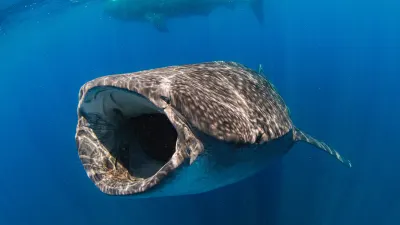Lying just 20 minutes by boat from Derawan, ‘Whale Shark Point’ is one of Kalimantan’s best kept secrets. But it won't be for long. Read on to learn more about this under-the-radar destination and its exceptional whale shark experiences.
Kalimantan's big secret, whale sharks
Over the last few years, word has slowly spread of encounters with groups of whale sharks congregating off the eastern coast of Indonesian Borneo, also known as Kalimantan. The sharks typically gather around fishing platforms, called ‘bagans’, to feed on anchovies escaping from the nets. The local fisherman refer to the whale sharks as Labetti, or sometimes Si Bintik, which means ‘spotted’. They believe the Labetti bring good luck as their appearance is frequently followed by bountiful catches of fish.

When can you see whale sharks in Indonesian Borneo
The best chance to see the whale sharks is during the new moon although there is still a chance of encountering them at other times of the month. However, when the south winds are blowing during the summer months - typically mid-June to mind-September - the fishing platforms and the whale sharks move to more sheltered areas around Talisayan, roughly two-hours from the Derawan.
What to expect from Kalimantan's whale shark experience
In other parts of Southeast Asia, such as Cenderawasih Bay in Indonesia and Donsol in the Philippines, whale sharks gather in similar circumstances and subsequently, these locations have become major attractions. However tourism in the Derawan Archipelago and surrounding area remains relatively low key, meaning these whale sharks encounters a far more relaxed experience.
The whale sharks feed in the early morning so trips from Derawan head out from the Scuba Junkie Resort at dawn and are back in time for a quick breakfast before the normal day’s diving schedule starts. When the whale sharks are around Talisayan, the boat leaves around 5am and returns in the early afternoon, so guests will miss the normal dives. The trip to Talisayan is very much dependent on good weather as the seas can get rough when the south winds are blowing.

Conservation of Kalimantan's whale sharks
To learn more about this population of whale sharks, surveys were carried out around Talisayan in 2014 and 2015 by a collaborative team of Indonesian and international scientists working for WWF, Conservation International, BPSPL and Whale Shark Indonesia. Much like a fingerprint, each whale shark has a unique pattern of spots on its skin and so the teams were able to ‘photo ID’ 27 individuals – 25 males and 2 females. In 2015, two males and one female first identified in 2014 were also seen again, suggesting that at least some of the sharks were returning to Talisayan and adding weight to the idea that these sheltered bays are likely to be an important area for the whale sharks.
As well as bringing luck to the fisherman, it is hoped that the whale sharks will also bring an important alternative livelihood to the local villages – one that is dependent on maintaining this population of incredible sharks for the future.

In June 2017, Scuba Junkie Sangalaki ran its inaugural ‘Whale shark week’. Guests were able to learn about these incredible fish, attend workshops with Simon Pierce from the Marine Megafauna Foundation and staff from BPSPL, as well as actually snorkel with the sharks at the local ‘bagans’.
All images courtesy of Scubazoo.




